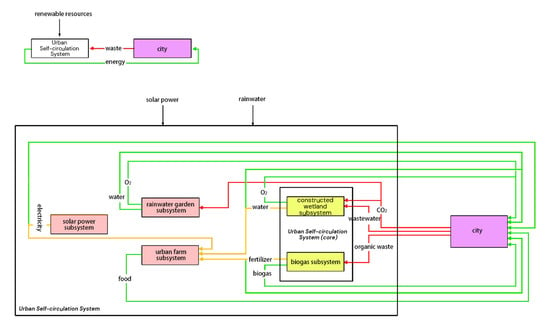Multi-System Urban Waste-Energy Self-Circulation: Design of Urban Self-Circulation System Based on Emergy Analysis
Abstract
:1. Introduction
2. Research Objectives and Methods of Urban Self-Circulation System
2.1. The Total Self-Circulating System
- Improvements to the waste utilization rate, to preclude the ecological damage otherwise caused by urban waste;
- Improvements to the resource utilization rate, to reduce waste and pollution during the resource production process.
- It makes full use of local climate and environmental characteristics, which makes it especially suitable for small and medium-sized livable cities that feature abundant sunshine and rainfall. It can therefore serve as a model in the development of such cities;
- It is highly effective and sustainable. Renewable resources are fully utilized in this system, with solar energy, rainwater, and municipal waste being the main energy inputs; in this way, input costs are reduced while ensuring sustainable energy outputs;
- This system is nonindustrial and causes little damage to the environment. The system operates in a nonindustrial way to control the discharge of harmful substances from the city to the environment, thus achieving a low environmental load. The rain gardens, constructed wetlands, and urban farms within the system provide additional environmental benefits as parts of the landscape itself.
2.1.1. Biogas Subsystem
- High conversion rate. Biogas systems can effectively convert organic waste into usable materials, including biogas and inorganic nitrogen and phosphorus;
- Clean energy source. Methane-rich biogas is a relatively clean energy source, and it can be used in combustion to generate heat or power. It is less damaging to the environment than fossil fuels and can effectively reduce organic pollutant emissions;
- Smaller emissions. Biogas systems have the advantage of emitting less greenhouse gas and transmitting fewer harmful pathogens than traditional manure systems (e.g., the transmission of pathogenic bacteria in manure is blocked).
2.1.2. Constructed Wetland Subsystem
2.1.3. Rainwater Garden Subsystem
2.1.4. Solar Power Subsystem
2.1.5. Urban Farm Subsystem
- Cost-effectiveness. More food is sourced locally, which reduces the energy waste and waste generation associated with food transport;
- Environmental optimization. Agricultural farming within the urban space is conducive to improving the urban environment;
- High degree of recyclability. Urban farming is a food system that helps advance the urban waste–resource–energy cycle—especially when combined with a broader urban waste–energy recycling system where the electricity and water needed for urban farming can be imported at no cost.
2.2. Transfer and Feasibility of Energy Self-Circulation
2.3. Advantages of a Self-Cycling City Model
- Scalability. The system makes full use of local climate and environmental characteristics. It is suitable for small and medium-sized livable cities with abundant sunlight and rainfall, and can be used as a model for developing such towns.
- Low cost of sustainable operation. Waste and wastewater in cities are treated by discrete subsystems so that resources can be reused, effectively reducing costs. It also produces additional resources, such as food and energy.
- Environmentally friendly. Increased waste utilization reduces environmental damage that would otherwise occur, and enhanced access to solar energy supplies reduces emissions of polluting gases.
3. Evaluation and Validation
3.1. Research Methodology: Evaluation of Urban Self-Cycle Systems Based on Emergy Analysis Methodology
3.2. Assessment Process
3.3. Data Analysis and Pre-Processing Based on Downtown Providence
3.4. Emergy Calculation
3.4.1. Before and after the Operation of Each Subsystem
3.4.2. Calculations for the Core Urban Self-Circulation System
3.4.3. The Urban Self-Circulation System
3.5. Overall Assessment Results of Subsystems
4. Discussion
5. Conclusions
- High emergy conversion. According to the results of the emergy analysis evaluation, the emergy conversion rate of this model is high, and the overall rate is better than that of the traditional model;
- Low cost. Circulation within multiple subsystems (waste–raw materials–energy) reduces resource waste and saves costs;
- Environmentally friendly. Recycling waste and utilizing clean energy reduces environmental pollution.
- Good system stability. A self-circulating city based on multiple systems can realize sustainable whole-system operations by leveraging internal circulation among distinct systems.
Funding
Institutional Review Board Statement
Informed Consent Statement
Data Availability Statement
Acknowledgments
Conflicts of Interest
References
- EFTEC. Valuing Our Natural Environment: Final Report; EFTEC: London, UK, 2006. [Google Scholar]
- Costanza, R.; de Groot, R.; Sutton, P.; van der Ploeg, S.; Anderson, S.; Kubiszewski, I.; Farber, S.; Turner, R. Changes in the global value of ecosystem services. Glob. Environ. Chang. 2014, 26, 152–158. [Google Scholar] [CrossRef]
- Pascual, U.; Muradian, R.; Rodríguez, L.; Duraiappah, A. Exploring the links between equity and efficiency in payments for environmental services: A conceptual approach. Ecol. Econ. 2010, 69, 1237–1244. [Google Scholar] [CrossRef]
- Brockerhoff, E.; Barbaro, L.; Castagneyrol, B.; Forrester, D.; Gardiner, B.; González-Olabarria, J.; Lyver, P.; Meurisse, N.; Oxbrough, A.; Taki, H.; et al. Forest biodiversity, ecosystem functioning and the provision of ecosystem services. Biodivers. Conserv. 2017, 26, 3005–3035. [Google Scholar] [CrossRef] [Green Version]
- Alberti, M. Maintaining ecological integrity and sustaining ecosystem function in urban areas. Curr. Opin. Environ. Sustain. 2010, 2, 178–184. [Google Scholar] [CrossRef]
- Liu, J.; Li, J.; Qin, K.; Zhou, Z.; Yang, X.; Li, T. Changes in land-uses and ecosystem services under multi-scenarios simulation. Sci. Total Environ. 2017, 586, 522–526. [Google Scholar] [CrossRef]
- Wang, J.; Zhou, W.; Pickett, S.; Yu, W.; Li, W. A multiscale analysis of urbanization effects on ecosystem services supply in an urban megaregion. Sci. Total Environ. 2019, 662, 824–833. [Google Scholar] [CrossRef] [PubMed]
- García-Nieto, A.; Geijzendorffer, I.; Baró, F.; Roche, P.; Bondeau, A.; Cramer, W. Impacts of urbanization around Mediterranean cities: Changes in ecosystem service supply. Ecol. Indic. 2018, 91, 589–606. [Google Scholar] [CrossRef] [Green Version]
- Li, B.; Chen, D.; Wu, S.; Zhou, S.; Wang, T.; Chen, H. Spatio-temporal assessment of urbanization impacts on ecosystem services: Case study of Nanjing City, China. Ecol. Indic. 2016, 71, 416–427. [Google Scholar] [CrossRef]
- Zhou, D.; Tian, Y.; Jiang, G. Spatio-temporal investigation of the interactive relationship between urbanization and ecosystem services: Case study of the Jingjinji urban agglomeration, China. Ecol. Indic. 2018, 95, 152–164. [Google Scholar] [CrossRef]
- Grimm, N.; Faeth, S.; Golubiewski, N.; Redman, C.; Wu, J.; Bai, X.; Briggs, J. Global Change and the Ecology of Cities. Science 2008, 319, 756–760. [Google Scholar] [CrossRef] [PubMed] [Green Version]
- Picchi, P.; van Lierop, M.; Geneletti, D.; Stremke, S. Advancing the relationship between renewable energy and ecosystem services for landscape planning and design: A literature review. Ecosyst. Serv. 2019, 35, 241–259. [Google Scholar] [CrossRef]
- Wan, L.; Ye, X.; Lee, J.; Lu, X.; Zheng, L.; Wu, K. Effects of urbanization on ecosystem service values in a mineral resource-based city. Habitat Int. 2015, 46, 54–63. [Google Scholar] [CrossRef]
- Tianhong, L.; Wenkai, L.; Zhenghan, Q. Variations in ecosystem service value in response to land use changes in Shenzhen. Ecol. Econ. 2010, 69, 1427–1435. [Google Scholar] [CrossRef]
- Xie, J.; Wu, X.; Tang, J.; Zhang, J.; Chen, X. Chemical fertilizer reduction and soil fertility maintenance in rice-fish coculture system. Front. Agric. China 2010, 4, 422–429. [Google Scholar] [CrossRef]
- Vromant, N.; Nhan, D.; Chau, N.; Ollevier, F. Can Fish Control Planthopper and Leafhopper Populations in Intensive Rice Culture. Biocontrol Sci. Technol. 2002, 12, 695–703. [Google Scholar] [CrossRef]
- Khalaf, D.; Metzidakis, J.; Ortega, E.; Sfakiotakis, E. Emergy Analysis of Irrigated Organic And Conventional Production Of Olive And Olive Oil N Crete, Greece “Preliminary Study”. Acta Hortic. 2003, 199–205. [Google Scholar] [CrossRef]
- Xi, Y.; Qin, P. Emergy evaluation of organic rice-duck mutualism system. Ecol. Eng. 2009, 35, 1677–1683. [Google Scholar] [CrossRef]
- Ciotola, R.; Lansing, S.; Martin, J. Emergy analysis of biogas production and electricity generation from small-scale agricultural digesters. Ecol. Eng. 2011, 37, 1681–1691. [Google Scholar] [CrossRef]
- Zhou, J.; Jiang, M.; Chen, B.; Chen, G. Emergy evaluations for constructed wetland and conventional wastewater treatments. Commun. Nonlinear Sci. Numer. Simul. 2009, 14, 1781–1789. [Google Scholar] [CrossRef]
- Law, E.; Diemont, S.; Toland, T. A sustainability comparison of green infrastructure interventions using emergy evaluation. J. Clean. Prod. 2017, 145, 374–385. [Google Scholar] [CrossRef]
- Brown, M.; Raugei, M.; Ulgiati, S. On boundaries and ‘investments’ in Emergy Synthesis and LCA: A case study on thermal vs. photovoltaic electricity. Ecol. Indic. 2012, 15, 227–235. [Google Scholar] [CrossRef]
- Lansing, S.; Botero, R.; Martin, J. Waste treatment and biogas quality in small-scale agricultural digesters. Bioresour. Technol. 2008, 99, 5881–5890. [Google Scholar] [CrossRef] [PubMed]
- Powers, W.; Van Horn, H.; Wilkie, A.; Wilcox, C.; Nordstedt, R. Effects of anaerobic digestion and additives to effluent or cattle feed on odor and odorant concentrations. J. Anim. Sci. 1999, 77, 1412. [Google Scholar] [CrossRef]
- Lansing, S.; Martin, J.; Botero, R.; da Silva, T.; da Silva, E. Methane production in low-cost, unheated, plug-flow digesters treating swine manure and used cooking grease. Bioresour. Technol. 2010, 101, 4362–4370. [Google Scholar] [CrossRef]
- Liu, Z. Life Cycle Analysis in Environmental Impact Assessment on Wastewater Treatment Plant; Peking University: Beijing, China, 2003. [Google Scholar]
- Zhou, Y. Research and Application of Wastewater Treatment in Longdao River; Technique Report: Beijing, China, 2005. [Google Scholar]
- Siracusa, G.; La Rosa, A. Design of a constructed wetland for wastewater treatment in a Sicilian town and environmental evaluation using the emergy analysis. Ecol. Model. 2006, 197, 490–497. [Google Scholar] [CrossRef]
- Demuzere, M.; Orru, K.; Heidrich, O.; Olazabal, E.; Geneletti, D.; Orru, H.; Bhave, A.; Mittal, N.; Feliu, E.; Faehnle, M. Mitigating and adapting to climate change: Multi-functional and multi-scale assessment of green urban infrastructure. J. Environ. Manag. 2014, 146, 107–115. [Google Scholar] [CrossRef]
- Netusil, N.; Levin, Z.; Shandas, V.; Hart, T. Valuing green infrastructure in Portland, Oregon. Landsc. Urban Plan. 2014, 124, 14–21. [Google Scholar] [CrossRef]
- Battisti, R.; Corrado, A. Evaluation of technical improvements of photovoltaic systems through life cycle assessment methodology. Energy 2005, 30, 952–967. [Google Scholar] [CrossRef]
- Kolagar, M. Adherence to Urban Agriculture in Order to Reach Sustainable Cities; A BWM–WASPAS Approach. Smart Cities 2019, 2, 31–45. [Google Scholar] [CrossRef] [Green Version]
- Feagan, R. The place of food: Mapping out the ‘local’ in local food systems. Prog. Hum. Geogr. 2007, 31, 23–42. [Google Scholar] [CrossRef] [Green Version]
- O’Kane, G. What is the real cost of our food? Implications for the environment, society and public health nutrition. Public Health Nutr. 2011, 15, 268–276. [Google Scholar] [CrossRef] [Green Version]
- Maassen, J. Emergy of an Urban Food Production System: A Case Study of Urban Agriculture in Detroit, Michigan; Uppsala University: Uppsala, Sweden, 2017. [Google Scholar]
- La Rosa, D.; Barbarossa, L.; Privitera, R.; Martinico, F. Agriculture and the city: A method for sustainable planning of new forms of agriculture in urban contexts. Land Use Policy 2014, 41, 290–303. [Google Scholar] [CrossRef]
- Beck, T.; Quigley, M.; Martin, J. Emergy evaluation of food production in urban residential landscapes. Urban Ecosyst. 2001, 5, 187–207. [Google Scholar] [CrossRef]
- Odum, H.T. Environmental Accounting: Emergy and Environmental Decision Making; Wiley: Hoboken, NJ, USA, 1996; Volume 34. [Google Scholar]
- Kang, D.; Park, S. Emergy evaluation perspectives of a multipurpose dam proposal in Korea. J. Environ. Manag. 2002, 66, 293–306. [Google Scholar] [CrossRef]
- Odum, H.T.; Brown, M.T.; Williams, S.B. Handbook of Emergy Evaluation: A Compendium of Data for Emergy Computation Issued in a Series of Folios; University of Florida: Gainesville, FL, USA, 2000. [Google Scholar]
- Ulgiati, S.; Brown, M.; Bastianoni, S.; Marchettini, N. Emergy-based indices and ratios to evaluate the sustainable use of resources. Ecol. Eng. 1995, 5, 519–531. [Google Scholar] [CrossRef]
- Rhode Island—State Energy Profile Overview—U.S. Energy Information Administration (EIA). Available online: https://www.eia.gov/state/?sid=RI (accessed on 17 May 2021).
- Gerardi, M. The Microbiology of Anaerobic Digesters; Wiley-Interscience: Hoboken, NJ, USA, 2003. [Google Scholar]
- Buenfil, A. Emergy Evaluation of Water. Ph.D. Thesis, University of Florida, Gainesville, FL, USA, 2001. [Google Scholar]
- Bastianoni, S.; Marchettini, N. The problem of co-production in environmental accounting by emergy analysis. Ecol. Model. 2000, 129, 187–193. [Google Scholar] [CrossRef]
- Buranakarn, V. Evaluation of Recycling and Reuse of Building Materials Using the Emergy Analysis Method; University of Florida: Gainesville, FL, USA, 1998. [Google Scholar]
- Handbook of Calculation of the Emergy. Available online: https://www.unicamp.br/fea/ortega/curso/handbook.htm (accessed on 17 May 2021).
- Cao, K.; Feng, X. Distribution of Emergy Indices and Its Application. Energy Fuels 2007, 21, 1717–1723. [Google Scholar] [CrossRef]
- Constructed Wetlands Treatment of Municipal Wastewaters. Available online: http://epa.gov/owow/wetlands/pdf/Design_Manual2000.pdf (accessed on 26 June 2021).
- Brown, M.; Ulgiati, S. Emergy evaluations and environmental loading of electricity production systems. J. Clean. Prod. 2002, 10, 321–334. [Google Scholar] [CrossRef]
- Björklund, J.; Geber, U.; Rydberg, T. Emergy analysis of municipal wastewater treatment and generation of electricity by digestion of sewage sludge. Resour. Conserv. Recycl. 2001, 31, 293–316. [Google Scholar] [CrossRef]
- Brown, M.; Bardi, E. Handbook of Emergy Evaluation Folio #3; University of Florida: Gainesville, FL, USA, 2001. [Google Scholar]
- Jiang, M. Study of Thermodynamic Mechanisms of the Urban Development and Its Application: BEIJING as a Case. Ph.D. Thesis, Peking University, Beijing, China, 2001. [Google Scholar]
- Brown, M.; Campbell, D.; Tilley, D. Emergy Synthesis 8~Emergy and environmental accounting: Theories, applications, and methodologies. Ecol. Model. 2015, 315, 1–3. [Google Scholar] [CrossRef]
- Brown, M.; Buranakarn, V. Emergy indices and ratios for sustainable material cycles and recycle options. Resour. Conserv. Recycl. 2003, 38, 1–22. [Google Scholar] [CrossRef]
- Heusinger, J.; Weber, S. Surface energy balance of an extensive green roof as quantified by full year eddy-covariance measurements. Sci. Total Environ. 2017, 577, 220–230. [Google Scholar] [CrossRef]
- Ascione, M.; Campanella, L.; Cherubini, F.; Ulgiati, S. Environmental driving forces of urban growth and development. Landsc. Urban Plan. 2009, 93, 238–249. [Google Scholar] [CrossRef]
- Duan, N.; Liu, X.; Dai, J.; Lin, C.; Xia, X.; Gao, R.; Wang, Y.; Chen, S.; Yang, J.; Qi, J. Evaluating the environmental impacts of an urban wetland park based on emergy accounting and life cycle assessment: A case study in Beijing. Ecol. Model. 2011, 222, 351–359. [Google Scholar] [CrossRef]
- Zhang, Y.; Yang, Z.; Liu, G.; Yu, X. Emergy analysis of the urban metabolism of Beijing. Ecol. Model. 2011, 222, 2377–2384. [Google Scholar] [CrossRef]
- Brown, M.; Ulgiati, S. Assessing the global environmental sources driving the geobiosphere: A revised emergy baseline. Ecol. Model. 2016, 339, 126–132. [Google Scholar] [CrossRef] [Green Version]
- Lefroy, E.; Rydberg, T. Emergy evaluation of three cropping systems in southwestern Australia. Ecol. Model. 2003, 161, 195–211. [Google Scholar] [CrossRef] [Green Version]
- Gao, J.; Ti, C.; Chen, N. Environmental Comparison of Straw Applications Based on a Life Cycle Assessment Model and Emergy Evaluation. BioResources 2014, 10, 548–565. [Google Scholar] [CrossRef]
- Wu, P.; Ma, X.; Ji, J.; Ma, Y. Review on Life Cycle Assessment of Greenhouse Gas Emission Profit of Solar Photovoltaic Systems. Energy Procedia 2017, 105, 1289–1294. [Google Scholar] [CrossRef]
- Brown, M.; Protano, G.; Ulgiati, S. Assessing geobiosphere work of generating global reserves of coal, crude oil, and natural gas. Ecol. Model. 2011, 222, 879–887. [Google Scholar] [CrossRef]
- Brown, M.; Ulgiati, S. Updated evaluation of exergy and emergy driving the geobiosphere: A review and refinement of the emergy baseline. Ecol. Model. 2010, 221, 2501–2508. [Google Scholar] [CrossRef]
- Zarbá, L.; Brown, M. Cycling emergy: Computing emergy in trophic networks. Ecol. Model. 2015, 315, 37–45. [Google Scholar] [CrossRef]
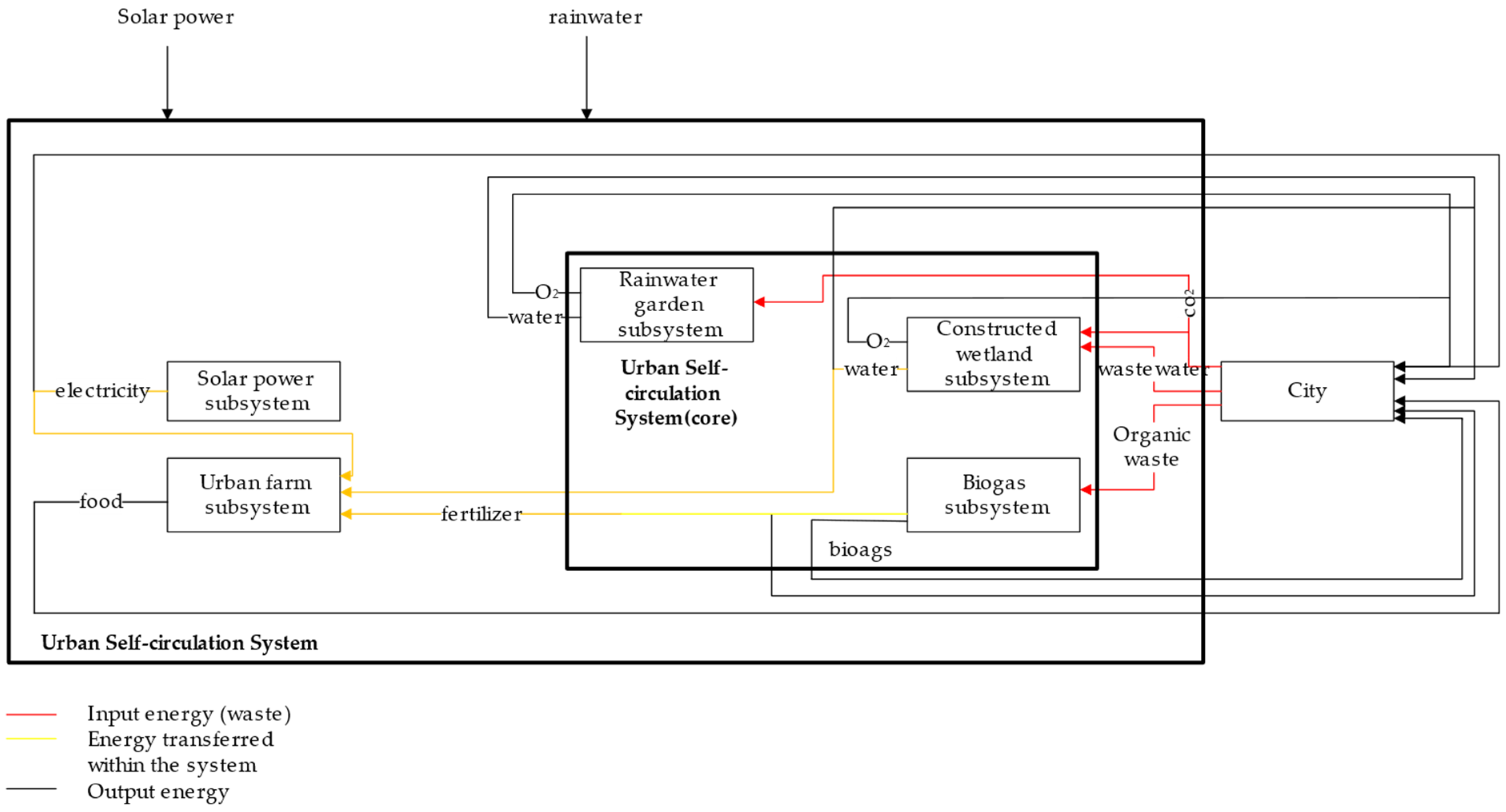
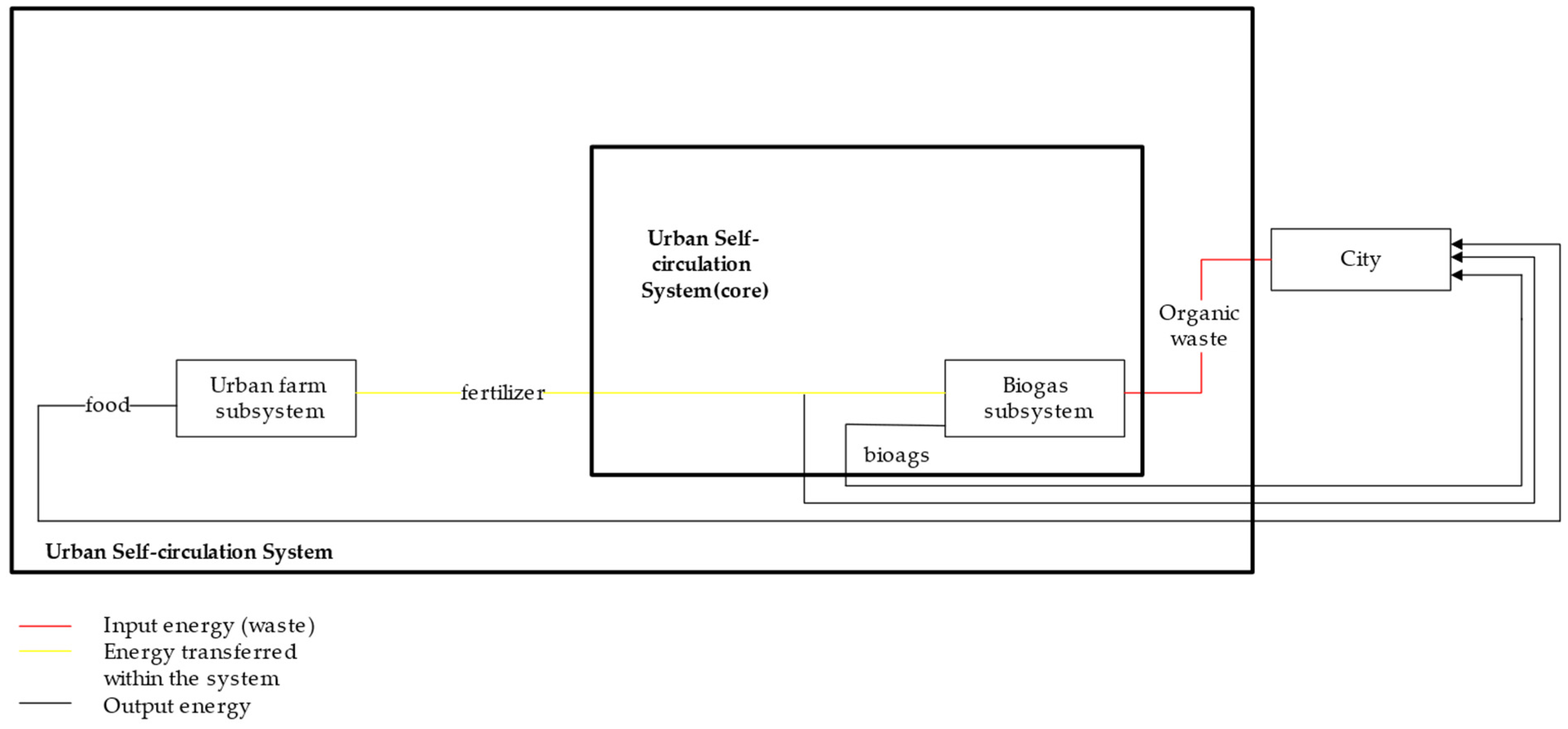


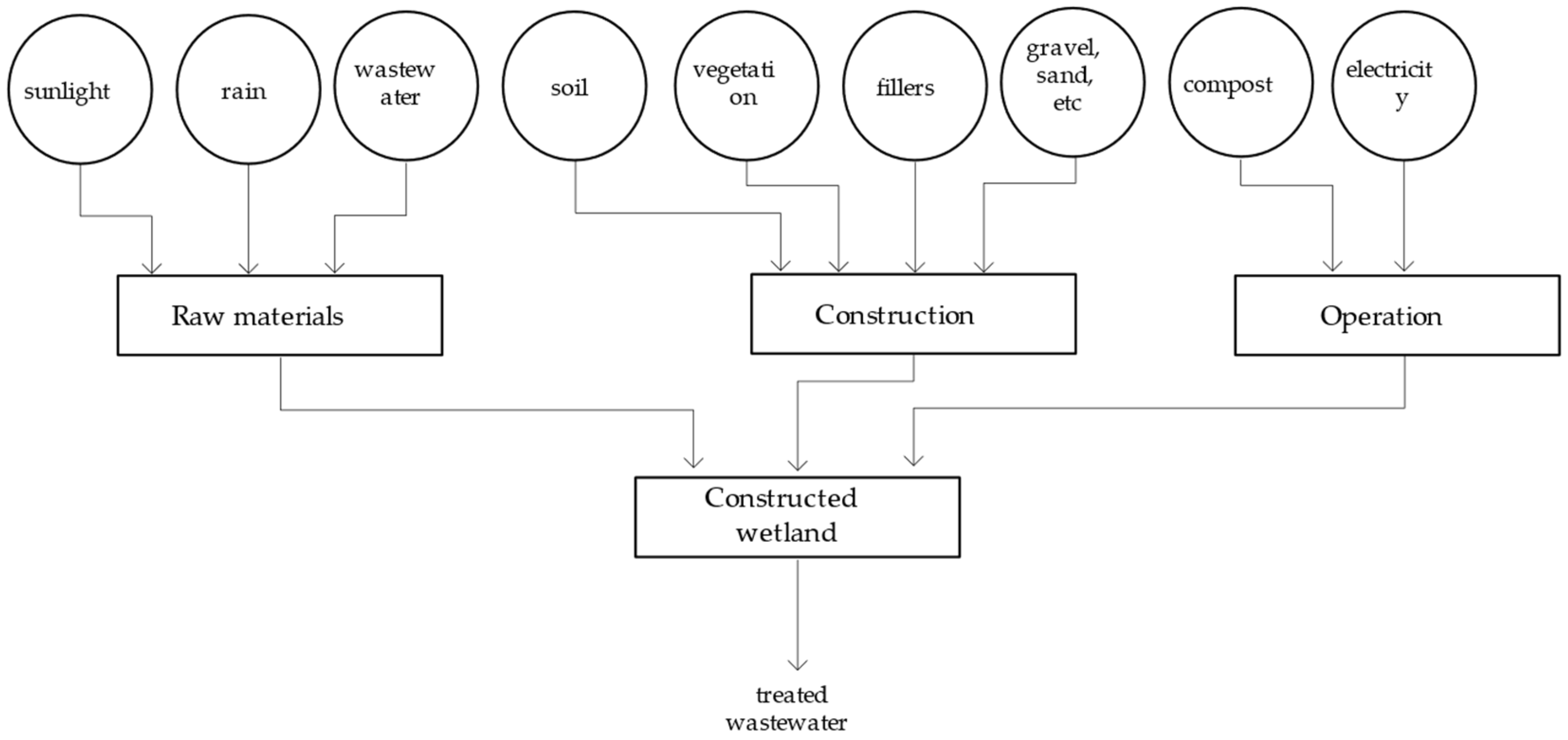

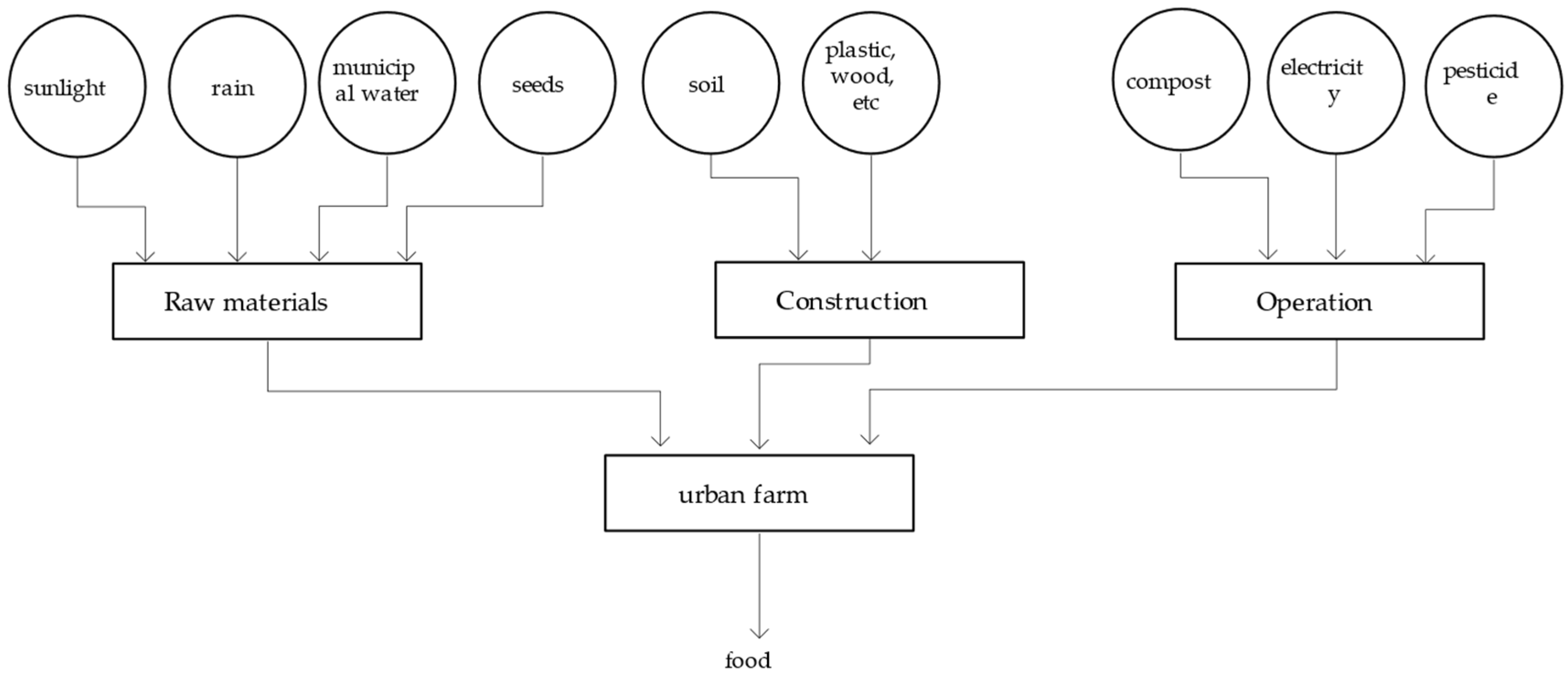
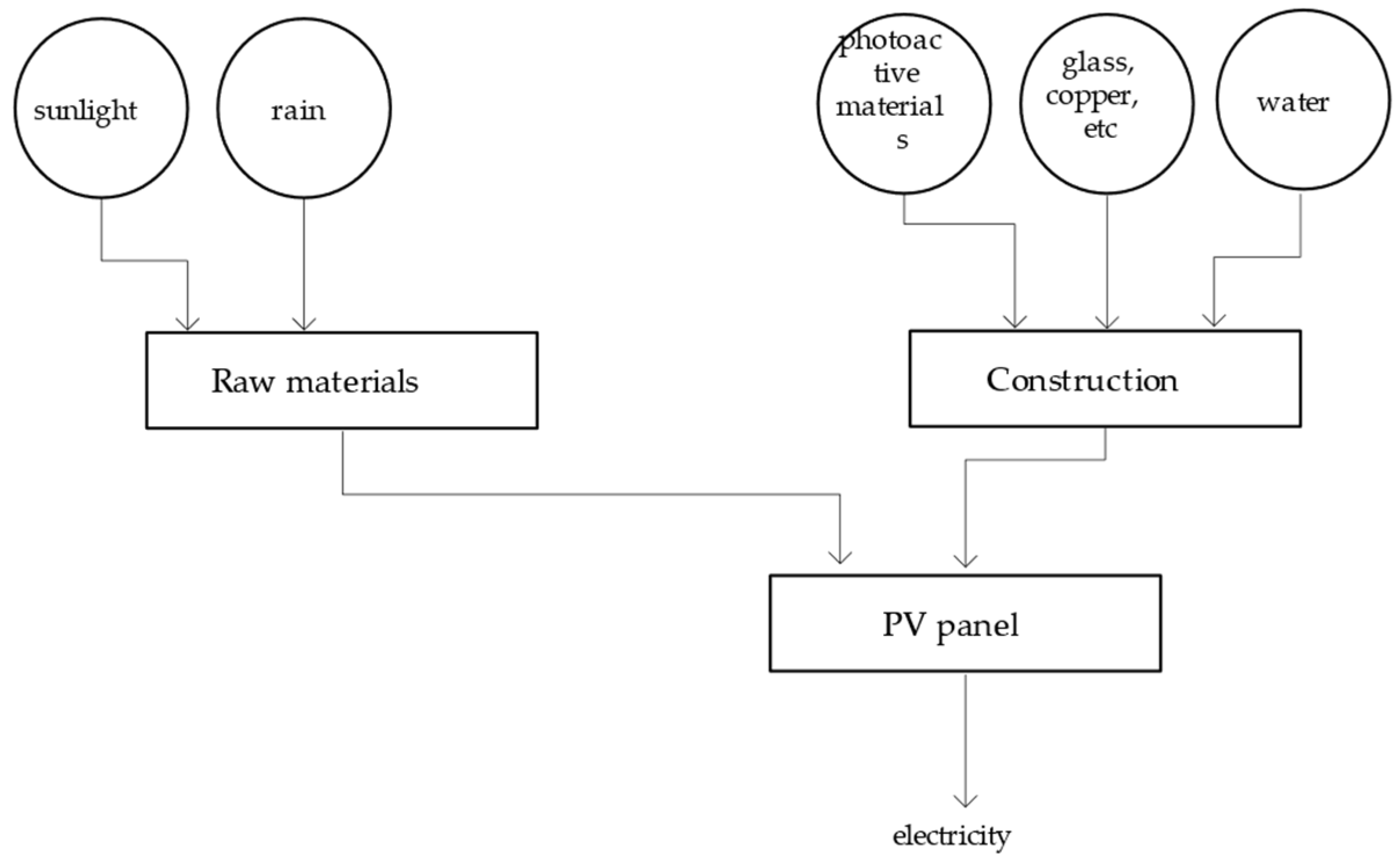
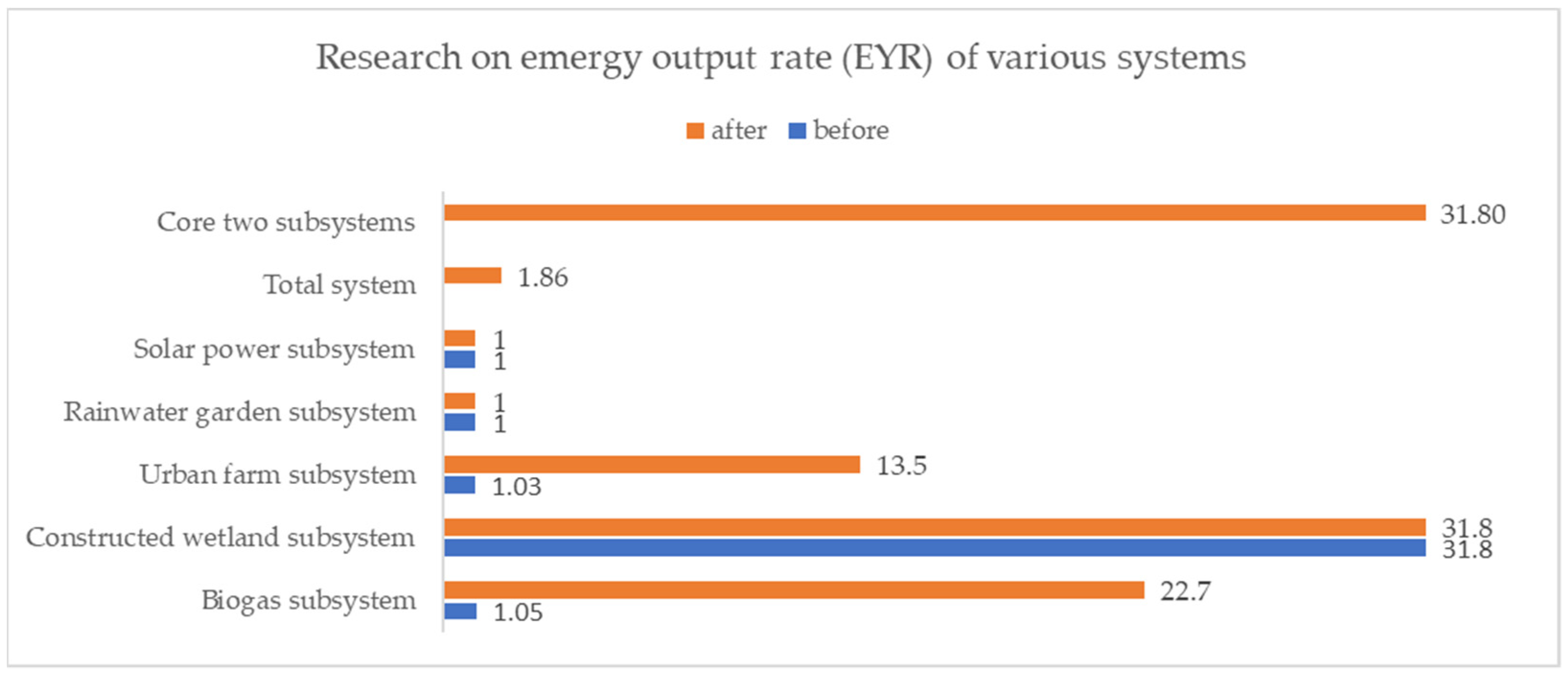
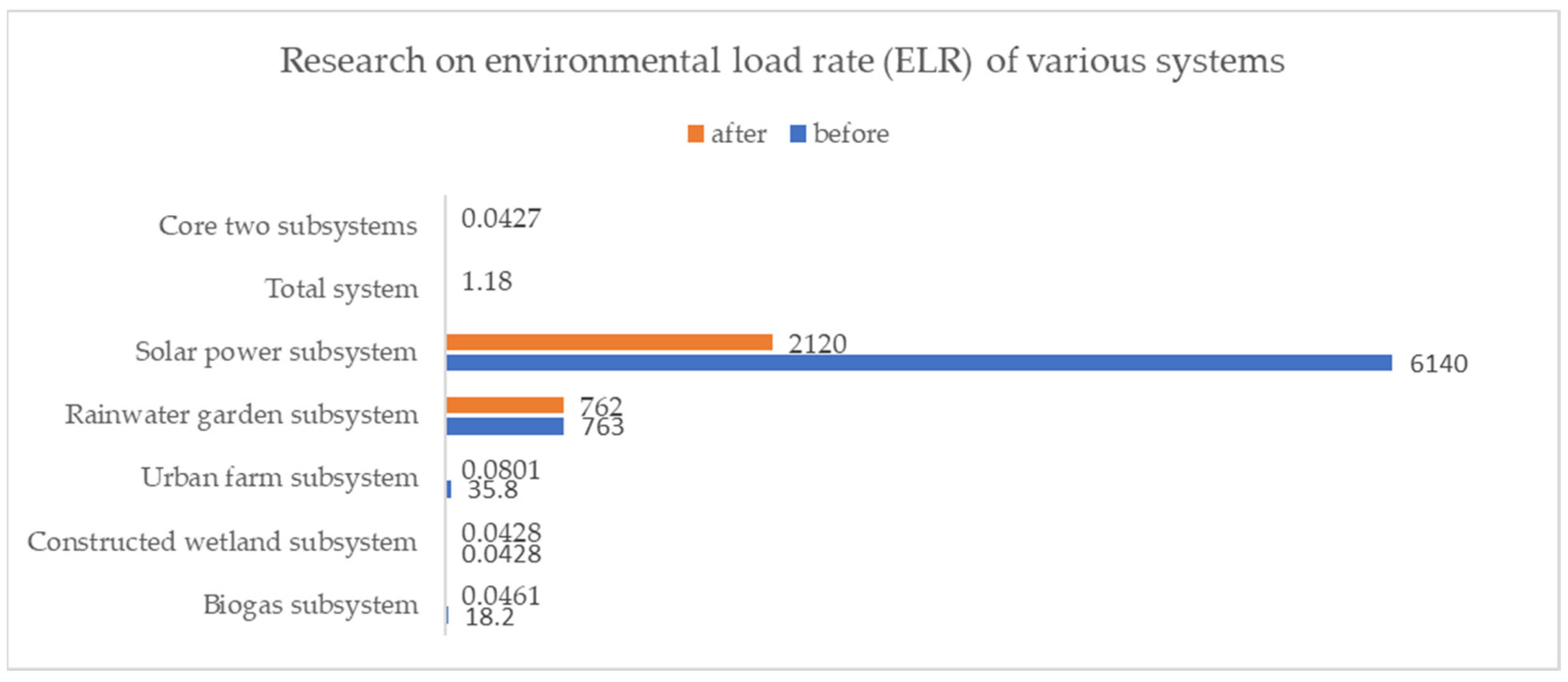
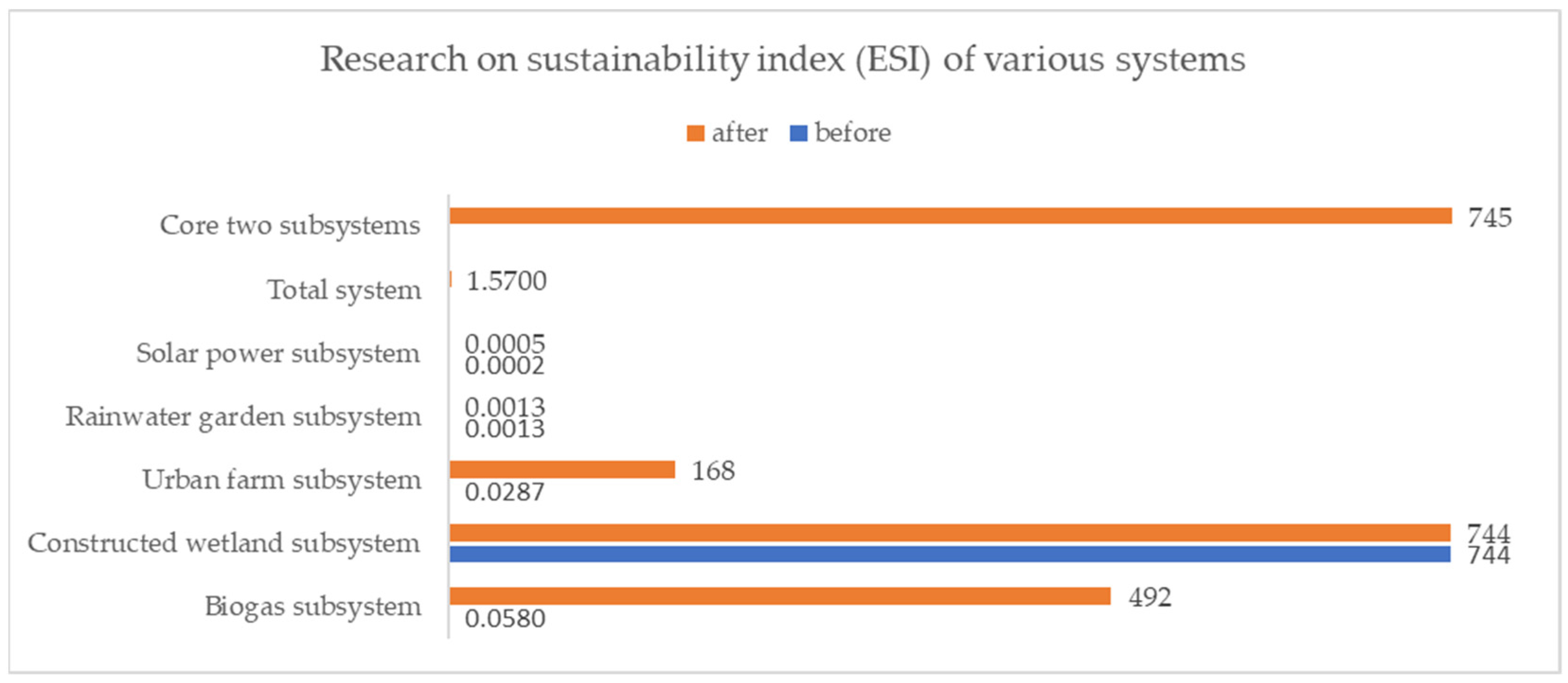
| Resource | Unit | Sum |
|---|---|---|
| Electricity | J | 2.75 × 1014 |
| Organic waste | g | 5.74 × 109 |
| Water | J | 2.97 × 1016 |
| Food | Kg | 9.54 × 106 |
| Unit | Units/Year | Transformity (sej/Unit) | Emergy (sej/Year) | |
|---|---|---|---|---|
| Renewable resources (R) | ||||
| Sunlight | J | 2.37 × 1013 | 1 | 2.37 × 1013 |
| Water [44] | m3 | 1.01 × 105 | 3.23 × 1011 | 3.26 × 1016 |
| Electricity (from the system) [38] | J | 0 | 1.65 × 105 | 0 |
| Manure (from the system) [45] | g | 0 | 9.70 × 107 | 0 |
| R | 3.25 × 1016 | |||
| Purchased resources (F) | ||||
| Electricity(purchased) [38] | J | 4.69 × 1010 | 1.65 × 105 | 7.73 × 1015 |
| Plastic [46] | g | 4.15 × 105 | 5.87 × 109 | 2.44 × 1015 |
| Zinc [47] | g | 2.14 × 105 | 1.58 × 1010 | 3.38 × 1015 |
| Steel [46] | g | 3.58 × 106 | 4.15 × 109 | 1.49 × 1016 |
| PVC [48] | g | 1.38 × 105 | 1.14 × 1010 | 1.57 × 1015 |
| Wood [46] | g | 6.00 × 106 | 8.80 × 108 | 5.28 × 1015 |
| Manure (purchased) [45] | g | 5.74 × 109 | 9.70 × 107 | 5.57 × 1017 |
| F | 5.92 × 1017 | |||
| U | 6.24 × 1017 | |||
| Products | ||||
| Biogas | J | 1.23 × 1013 | ||
| Ammonia nitrogen | g | 7.69 × 106 | ||
| Phosphate phosphorus | g | 9.04 × 105 | ||
| EYR | 1.05 × 100 | |||
| ELR | 1.82 × 10 | |||
| ESI | 5.80 × 10−2 |
| Unit | Units/Year | Transformity (sej/Unit) | Emergy (sej/Year) | |
|---|---|---|---|---|
| Renewable resources (R) | ||||
| Sunlight | J | 2.37 × 1013 | 1 | 2.37 × 1013 |
| Water [44] | m3 | 1.01 × 105 | 3.23 × 1011 | 3.26 × 1016 |
| Electricity (from the system) [38] | J | 4.68 × 1010 | 1.65 × 105 | 7.72 × 1015 |
| Manure (from the system) [45] | g | 5.74 × 109 | 9.70 × 107 | 5.57 × 1017 |
| R | 5.97 × 1017 | |||
| Purchased resources (F) | ||||
| Electricity(purchased) [38] | J | 0 | 1.65 × 105 | 0 |
| Plastic [46] | g | 4.15 × 105 | 5.87 × 109 | 2.44 × 1015 |
| Zinc [47] | g | 2.14 × 105 | 1.58 × 1010 | 3.37 × 1015 |
| Steel [46] | g | 3.58 × 106 | 4.15 × 109 | 1.49 × 1016 |
| PVC [48] | g | 1.38 × 105 | 1.14 × 1010 | 1.57 × 1015 |
| Wood [46] | g | 6.00 × 106 | 8.80 × 108 | 5.28 × 1015 |
| Manure (purchased) [45] | g | 0 | 9.70 × 107 | 0 |
| F | 2.75 × 1016 | |||
| U | 6.24 × 1017 | |||
| Products | ||||
| Biogas | J | 1.23 × 1013 | ||
| Ammonia nitrogen | g | 7.68 × 106 | ||
| Phosphate phosphorus | g | 9.04 × 105 | ||
| EYR | 2.27 × 10 | |||
| ELR | 4.61 × 10−2 | |||
| ESI | 4.92 × 102 |
| Unit | Units/Year | Transformity (sej/Unit) | Emergy (sej/Year) | |
|---|---|---|---|---|
| Renewable resources (R) | ||||
| Sunlight | J | 1.57 × 1017 | 1 | 1.57 × 1017 |
| Rain [50] | J | 7.44 × 1013 | 1.42 × 104 | 1.06 × 1018 |
| Wastewater inflow [51] | J | 2.97 × 1016 | 3.80 × 106 | 1.13 × 1023 |
| R | 1.13 × 1023 | |||
| Non-renewable resources (N) | ||||
| Soil [52] | J | 1.04 × 1015 | 7.40 × 104 | 7.70 × 1019 |
| Organic compost [52] | J | 5.96 × 1015 | 7.40 × 104 | 4.41 × 1020 |
| Wood fiber peat [52] | J | 7.79 × 1015 | 7.40 × 104 | 5.76 × 1020 |
| Activated sludge [52] | J | 4.29 × 1014 | 7.40 × 104 | 3.17 × 1019 |
| N | 1.13 × 1021 | |||
| Purchased resources (F) | ||||
| Gravel [38] | g | 1.12 × 1012 | 1.00 × 109 | 1.12 × 1021 |
| Sand [38] | g | 1.58 × 1012 | 1.00 × 109 | 1.58 × 1021 |
| Vegetation [53] | $ | 2.62 × 107 | 1.16 × 1013 | 3.04 × 1020 |
| Iron ore powder [54] | g | 1.58 × 1011 | 1.28 × 109 | 2.02 × 1020 |
| PC liner [38] | J | 7.85 × 1013 | 1.11 × 105 | 8.71 × 1018 |
| PE pipe [38] | J | 1.73 × 1013 | 1.11 × 105 | 1.92 × 1018 |
| Geotextile [38] | J | 1.71 × 1013 | 1.11 × 105 | 1.90 × 1018 |
| Steel griller [55] | g | 4.94 × 107 | 4.13 × 109 | 2.04 × 1017 |
| Bricks and cement [55] | g | 1.39 × 1011 | 1.97 × 109 | 2.74 × 1020 |
| Machinery [52] | g | 4.12 × 108 | 6.70 × 109 | 2.76 × 1018 |
| Electricity [38] | J | 1.23 × 1015 | 1.66 × 105 | 1.96 × 1020 |
| F | 3.70 × 1021 | |||
| U | 1.18 × 1023 | |||
| Products | ||||
| Treated wastewater | J | 2.48 × 1016 | ||
| EYR | 3.19 × 10 | |||
| ELR | 4.27 × 10−2 | |||
| ESI | 7.47 × 102 |
| Unit | Units/Year | Transformity (sej/Unit) | Emergy (sej/Year) | |
|---|---|---|---|---|
| Renewable resources (R) | ||||
| Sun | J | 1.05 × 1018 | 1 | 1.05 × 1018 |
| Rain [50] | J | 1.19 × 1016 | 1.42 × 104 | 1.69 × 1020 |
| Fertilizers (from the system) [38] | g | 0 | 8.28 × 109 | 0 |
| Municipal water (from the system) [55] | J | 0 | 4.31 × 105 | 0 |
| R | 1.69 × 1020 | |||
| Non-renewable resources (N) | ||||
| Net topsoil loss [56] | J | 3.49 × 1013 | 1.24 × 105 | 4.33 × 1018 |
| N | 4.33 × 1018 | |||
| Purchased resources (F) | ||||
| Constructed debris disposal [54] | g | 1.49 × 1014 | 1.94 × 108 | 2.89 × 1022 |
| Stone [57] | g | 1.90 × 1013 | 1.64 × 109 | 3.12 × 1022 |
| Topsoil [57] | J | 3.73 × 1013 | 1.68 × 109 | 6.26 × 1022 |
| Fertilizers(purchased) [38] | g | 3.25 × 109 | 8.28 × 109 | 2.69 × 1019 |
| Plant materials [58] | $ | 1.18 × 108 | 1.16 × 1013 | 1.37 × 1021 |
| Municipal water (purchased) [55] | J | 9.22 × 1010 | 4.31 × 105 | 3.97 × 1016 |
| HDPE pipe [57] | g | 3.45 × 109 | 9.68 × 109 | 3.34 × 1019 |
| PVC drain [54] | g | 9.04 × 109 | 9.68 × 109 | 8.75 × 1019 |
| Steel drain filter [58] | g | 1.12 × 109 | 6.92 × 109 | 7.74 × 1018 |
| Hand tools [55] | g | 2.13 × 109 | 6.92 × 109 | 1.47 × 1019 |
| Heavy machinery [58] | $ | 4.30 × 108 | 1.16 × 1013 | 4.98 × 1021 |
| F | 1.29 × 1023 | |||
| U | 1.29 × 1023 | |||
| Products | ||||
| Water | J | 4.88 × 1015 | ||
| EYR | 1 | |||
| ELR | 7.63 × 102 | |||
| ESI | 1.31 × 10−3 |
| Unit | Units/Year | Transformity (sej/Unit) | Emergy (sej/Year) | |
|---|---|---|---|---|
| Renewable resources (R) | ||||
| Sun | J | 1.05 × 1018 | 1 | 1.05 × 1018 |
| Rain [50] | J | 1.19 × 1016 | 1.42 × 104 | 1.69 × 1020 |
| Fertilizers (from the system) [38] | g | 3.25 × 109 | 8.28 × 109 | 2.69 × 1019 |
| Municipal water (from the system) [55] | J | 9.22 × 1010 | 4.31 × 105 | 3.97 × 1016 |
| R | 1.69 × 1020 | |||
| Non-renewable resources (N) | ||||
| Net topsoil loss [56] | J | 3.49 × 1013 | 1.24 × 105 | 4.33 × 1018 |
| N | 4.33 × 1018 | |||
| Purchased resources (F) | ||||
| Constructed debris disposal [54] | g | 1.49 × 1014 | 1.94 × 108 | 2.89 × 1022 |
| Stone [57] | g | 1.90 × 1013 | 1.64 × 109 | 3.12 × 1022 |
| Topsoil [57] | g | 3.73 × 1013 | 1.68 × 109 | 6.27 × 1022 |
| Fertilizers(purchased) [38] | g | 0 | 8.28 × 109 | 0 |
| Plant materials [58] | $ | 1.18 × 108 | 1.16 × 1013 | 1.37 × 1021 |
| Municipal water (purchased) [55] | J | 0 | 4.31 × 105 | 0 |
| HDPE pipe [57] | g | 3.45 × 109 | 9.68 × 109 | 3.34 × 1019 |
| PVC drain [54] | g | 9.04 × 109 | 9.68 × 109 | 8.75 × 1019 |
| Steel drain filter [58] | g | 1.12 × 109 | 6.92 × 109 | 7.75 × 1018 |
| Hand tools [55] | g | 2.13 × 109 | 6.92 × 109 | 1.47 × 1019 |
| Heavy machinery [58] | $ | 4.30 × 108 | 1.16 × 1013 | 4.99 × 1021 |
| F | 1.29 × 1023 | |||
| U | 1.29 × 1023 | |||
| Products | ||||
| Water | J | 4.88 × 1015 | ||
| EYR | 1 | |||
| ELR | 7.62 × 102 | |||
| ESI | 1.31 × 10−3 |
| Unit | Units/Year | Transformity (sej/Unit) | Emergy (sej/Year) | |
|---|---|---|---|---|
| Renewable resources (R) | ||||
| Sunlight | J | 1.70 × 1016 | 1 | 1.70 × 1016 |
| Rain [50] | J | 1.73 × 1013 | 1.42 × 104 | 2.46 × 1017 |
| Electricity (from the system) [38] | J | 0 | 1.66 × 105 | 0 |
| Municipal water (from the system) [55] | J | 0 | 4.31 × 105 | 0 |
| Compost (from the system) [59] | g | 0 | 2.42 × 108 | 0 |
| R | 2.63 × 1017 | |||
| Purchased resources (F) | ||||
| Mulch [46] | J | 5.20 × 1011 | 2.76 × 104 | 1.44 × 1016 |
| Fuel [60] | g | 1.19 × 107 | 5.21 × 104 | 6.21 × 1011 |
| Organic matter [46] | J | 8.46 × 1011 | 5.85 × 104 | 4.95 × 1016 |
| Straw [46] | J | 3.25 × 1012 | 6.92 × 104 | 2.25 × 1017 |
| Cardboard [46] | J | 6.26 × 1011 | 1.12 × 105 | 7.01 × 1016 |
| Seeds [37] | J | 6.91 × 1011 | 2.88 × 105 | 1.99 × 1017 |
| Plastic [46] | g | 8.24 × 106 | 3.00 × 108 | 2.47 × 1015 |
| Wood [46] | g | 6.46 × 107 | 6.95 × 108 | 4.49 × 1016 |
| Brick [46] | g | 3.83 × 105 | 1.83 × 109 | 7.01 × 1014 |
| Aluminum [61] | g | 1.09 × 107 | 2.24 × 109 | 2.45 × 1016 |
| Steel [62] | g | 2.77 × 104 | 2.80 × 109 | 7.76 × 1013 |
| Rubber [46] | g | 6.19 × 106 | 3.40 × 109 | 2.10 × 1016 |
| Perlite [38] | kg | 1.83 × 107 | 3.56 × 109 | 6.52 × 1016 |
| Pesticide, neem oil [38] | kg | 2.46 × 102 | 1.26 × 1012 | 3.10 × 1014 |
| Electricity (purchased) [38] | J | 3.37 × 1012 | 1.66 × 105 | 5.60 × 1017 |
| Municipal water (purchased) [55] | J | 6.05 × 1010 | 4.31 × 105 | 2.61 × 1016 |
| Compost (purchased) [59] | g | 3.35 × 1010 | 2.42 × 108 | 8.10 × 1018 |
| F | 9.41 × 1018 | |||
| U | 9.67 × 1018 | |||
| Products | ||||
| Food | kg | 9.54 × 106 | ||
| EYR | 1.03 × 100 | |||
| ELR | 3.58 × 10 | |||
| ESI | 2.87 × 10−2 |
| Unit | Units/Year | Transformity (sej/Unit) | Emergy (sej/Year) | |
|---|---|---|---|---|
| Renewable resources (R) | ||||
| Sunlight | J | 1.70 × 1016 | 1 | 1.70 × 1016 |
| Rain [50] | J | 1.73 × 1013 | 1.42 × 104 | 2.46 × 1017 |
| Electricity (from the system) [38] | J | 3.37 × 1012 | 1.66 × 105 | 5.59 × 1017 |
| Municipal water (from the system) [55] | J | 6.05 × 1010 | 4.31 × 105 | 2.61 × 1016 |
| Compost (from the system) [59] | g | 3.35 × 1010 | 2.42 × 108 | 8.11 × 1018 |
| R | 8.95 × 1018 | |||
| Purchased resources (F) | ||||
| Mulch [46] | J | 5.20 × 1011 | 2.76 × 104 | 1.44 × 1016 |
| Fuel [60] | g | 1.19 × 107 | 5.21 × 104 | 6.20 × 1011 |
| Organic matter [46] | J | 8.46 × 1011 | 5.85 × 104 | 4.95 × 1016 |
| Straw [46] | J | 3.25 × 1012 | 6.92 × 104 | 2.25 × 1017 |
| Cardboard [46] | J | 6.26 × 1011 | 1.12 × 105 | 7.01 × 1016 |
| Seeds [37] | J | 6.91 × 1011 | 2.88 × 105 | 1.99 × 1017 |
| Plastic [46] | g | 8.24 × 106 | 3.00 × 108 | 2.47 × 1015 |
| Wood [46] | g | 6.46 × 107 | 6.95 × 108 | 4.49 × 1016 |
| Brick [46] | g | 3.83 × 105 | 1.83 × 109 | 7.01 × 1014 |
| Aluminum [61] | g | 1.09 × 107 | 2.24 × 109 | 2.44 × 1016 |
| Steel [62] | g | 2.77 × 104 | 2.80 × 109 | 7.76 × 1013 |
| Rubber [46] | g | 6.19 × 106 | 3.40 × 109 | 2.10 × 1016 |
| Perlite [38] | kg | 1.83 × 107 | 3.56 × 109 | 6.51 × 1016 |
| Pesticide, neem oil [38] | kg | 2.46 × 102 | 1.26 × 1012 | 3.10 × 1014 |
| Electricity (purchased) [38] | J | 0 | 1.66 × 105 | 0 |
| Municipal water (purchased) [55] | J | 0 | 4.31 × 105 | 0 |
| Compost (purchased) [59] | g | 0 | 2.42 × 108 | 0 |
| F | 7.17 × 1017 | |||
| U | 9.67 × 1018 | |||
| Products | ||||
| Food | kg | 9.54 × 106 | ||
| EYR | 1.35 × 10 | |||
| ELR | 8.01 × 10−2 | |||
| ESI | 1.68 × 102 |
| Unit | Units/Year | Transformity (sej/Unit) | Emergy (sej/Year) | |
|---|---|---|---|---|
| Renewable resources (R) | ||||
| Sunlight | J | 3.21 × 1015 | 1 | 3.21 × 1015 |
| Rain [50] | J | 7.60 × 107 | 1.42 × 104 | 1.08 × 1012 |
| Water (from the system) [44] | g | 0 | 1.59 × 106 | 0 |
| R | 3.21 × 1015 | |||
| Purchased resources (F) | ||||
| Fuel [52] | g | 1.64 × 106 | 6.22 × 109 | 1.02 × 1016 |
| Oil [52] | J | 1.74 × 108 | 1.48 × 105 | 2.58 × 1013 |
| Coal [64] | J | 2.98 × 109 | 8.17 × 104 | 2.44 × 1014 |
| Natural gas [65] | J | 4.81 × 108 | 1.70 × 105 | 8.18 × 1013 |
| Uranium [66] | g | 2.93 × 100 | 1.68 × 1011 | 4.92 × 1011 |
| Photoactive materials [65] | g | 2.46 × 107 | 5.76 × 1011 | 1.42 × 1019 |
| Glass [65] | g | 3.81 × 108 | 8.00 × 109 | 3.05 × 1018 |
| Copper [66] | g | 1.52 × 107 | 1.02 × 1011 | 1.55 × 1018 |
| Aluminum [66] | g | 2.47 × 107 | 5.73 × 109 | 1.41 × 1017 |
| Steel [66] | g | 5.81 × 107 | 1.24 × 1010 | 7.20 × 1017 |
| EVA and plastics [64] | g | 1.27 × 107 | 6.22 × 109 | 7.89 × 1016 |
| Water (purchased) [44] | g | 3.82 × 109 | 1.59 × 106 | 6.07 × 1015 |
| F | 1.97 × 1019 | |||
| U | 1.97 × 1019 | |||
| Products | ||||
| Electricity | J | 2.79 × 1014 | ||
| EYR | 1.00 × 100 | |||
| ELR | 6.14 × 103 | |||
| ESI | 1.63 × 10−4 |
| Unit | Units/Year | Transformity (sej/Unit) | Emergy (sej/Year) | |
|---|---|---|---|---|
| Renewable resources (R) | ||||
| Sunlight | J | 3.21 × 1015 | 1 | 3.21 × 1015 |
| Rain [50] | J | 7.60 × 107 | 1.42 × 104 | 1.08 × 1012 |
| Water (from the system) [44] | g | 3.82 × 109 | 1.59 × 106 | 6.07 × 1015 |
| R | 9.28 × 1015 | |||
| Purchased resources (F) | ||||
| Fuel [52] | g | 1.64 × 106 | 6.22 × 109 | 1.02 × 1016 |
| Oil [52] | J | 1.74 × 108 | 1.48 × 105 | 2.58 ×1013 |
| Coal [64] | J | 2.98 × 109 | 8.17 × 104 | 2.44 × 1014 |
| Natural gas [65] | J | 4.81 × 108 | 1.70 × 105 | 8.18 × 1013 |
| Uranium [66] | g | 2.93 × 100 | 1.68 × 1011 | 4.92 × 1011 |
| Photoactive materials [65] | g | 2.46 × 107 | 5.76 × 1011 | 1.42 × 1019 |
| Glass [65] | g | 3.81 × 108 | 8.00 × 109 | 3.05 × 1018 |
| Copper [66] | g | 1.52 × 107 | 1.02 × 1011 | 1.55 × 1018 |
| Aluminum [66] | g | 2.47 × 107 | 5.73 × 109 | 1.41 × 1017 |
| Steel [66] | g | 5.81 × 107 | 1.24 × 1010 | 7.20 × 1017 |
| EVA and plastics [64] | g | 1.27 × 107 | 6.22 × 109 | 7.89 × 1016 |
| Water (purchased) [44] | g | 0 | 1.59 × 106 | 0 |
| F | 1.97 × 1019 | |||
| U | 1.97 × 1019 | |||
| Products | ||||
| Electricity | J | 2.79 × 1014 | ||
| EYR | 1.00 × 100 | |||
| ELR | 2.12 × 103 | |||
| ESI | 4.71 × 10−4 |
| EYR | ELR | ESI | |
|---|---|---|---|
| Biogas (before) | 1.05 × 100 | 1.82 × 10 | 5.80 × 10−2 |
| Biogas (after) | 2.27 × 10 | 4.61 × 10−2 | 4.92 × 102 |
| Constructed wetland | 3.18 × 10 | 4.28 × 10−2 | 7.44 × 102 |
| Urban farm (before) | 1.03 × 100 | 3.58 × 10 | 2.87 × 10−2 |
| Urban farm (after) | 1.35 × 10 | 8.01 × 10−2 | 1.68 × 102 |
| Rainwater garden (before) | 1 | 7.63 × 102 | 1.31 × 10−3 |
| Rainwater garden (after) | 1 | 7.62 × 102 | 1.31 × 10−3 |
| Solar power subsystem (before) | 1 | 6.14 × 103 | 1.63 × 10−4 |
| Solar power subsystem (after) | 1 | 2.12 × 103 | 4.71 × 10−4 |
| Total system | 1.86 × 100 | 1.18 × 100 | 1.57 × 100 |
| Core two subsystems | 3.18 × 10 | 4.27 × 10−2 | 7.45 × 102 |
Publisher’s Note: MDPI stays neutral with regard to jurisdictional claims in published maps and institutional affiliations. |
© 2021 by the author. Licensee MDPI, Basel, Switzerland. This article is an open access article distributed under the terms and conditions of the Creative Commons Attribution (CC BY) license (https://creativecommons.org/licenses/by/4.0/).
Share and Cite
Xu, X. Multi-System Urban Waste-Energy Self-Circulation: Design of Urban Self-Circulation System Based on Emergy Analysis. Int. J. Environ. Res. Public Health 2021, 18, 7538. https://doi.org/10.3390/ijerph18147538
Xu X. Multi-System Urban Waste-Energy Self-Circulation: Design of Urban Self-Circulation System Based on Emergy Analysis. International Journal of Environmental Research and Public Health. 2021; 18(14):7538. https://doi.org/10.3390/ijerph18147538
Chicago/Turabian StyleXu, Xiaoyu. 2021. "Multi-System Urban Waste-Energy Self-Circulation: Design of Urban Self-Circulation System Based on Emergy Analysis" International Journal of Environmental Research and Public Health 18, no. 14: 7538. https://doi.org/10.3390/ijerph18147538
APA StyleXu, X. (2021). Multi-System Urban Waste-Energy Self-Circulation: Design of Urban Self-Circulation System Based on Emergy Analysis. International Journal of Environmental Research and Public Health, 18(14), 7538. https://doi.org/10.3390/ijerph18147538




